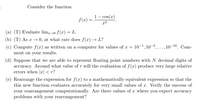
Advanced Engineering Mathematics
10th Edition
ISBN: 9780470458365
Author: Erwin Kreyszig
Publisher: Wiley, John & Sons, Incorporated
expand_more
expand_more
format_list_bulleted
Concept explainers
Question

Transcribed Image Text:Consider the function
1- cos(x)
f (x) =
(a) (T) Evaluate lim,0 f(x) = L.
(b) (T) As x 0, at what rate does f(x) → L?
(c) Compute f(x) as written on a computer for values of x = 10-1, 10–2, ., 10-10. Com-
ment on your results.
(d) Suppose that we are able to represent floating point numbers with N decimal digits of
accuracy. Around what value of r will the evaluation of f(x) produce very large relative
errors when |x| < r?
(e) Rearrange the expression for f(x) to a mathematically equivalent expression so that the
this new function evaluates accurately for very small values of x. Verify the success of
your rearrangement computationally. Are there values of x where you expect accuracy
problems with your rearrangement?
Expert Solution
This question has been solved!
Explore an expertly crafted, step-by-step solution for a thorough understanding of key concepts.
This is a popular solution
Trending nowThis is a popular solution!
Step by stepSolved in 2 steps

Knowledge Booster
Learn more about
Need a deep-dive on the concept behind this application? Look no further. Learn more about this topic, advanced-math and related others by exploring similar questions and additional content below.Similar questions
- (6) 4. Consider the graph given below of a function, f(x): 2 -1- -2- -3- (a) Evaluate the following (use DNE if the answer does not exist): lim f(r) = lim f(r) = f(-1) = lim f(r) = lim f(x) = f(2) = I+2+ (b) List all points of discontinuity for f (x). 2.arrow_forwardSuppose s(t) = 9 In(+1) is the position of an object measured in centimeters at t seconds. (a) Find the average velocity of the object from t = 6 seconds to t = 16 seconds. Give your answer to two decimal places. -Select-- V (b) Which of the following represents the instantaneous velocity of the object at t = 4? (Select yes or no.) lim 5(4+h)-s(4) 10 h lim s(t+h)-s(t) t-4 h s(4) s(3) 4-3 The slope of the graph of s(t) at t = 4 lim s(t) - s(4) t-4 t-4 -Select--- ♥ --Select-- -Select-- -Select-- ♥ -Select-arrow_forward
Recommended textbooks for you
 Advanced Engineering MathematicsAdvanced MathISBN:9780470458365Author:Erwin KreyszigPublisher:Wiley, John & Sons, Incorporated
Advanced Engineering MathematicsAdvanced MathISBN:9780470458365Author:Erwin KreyszigPublisher:Wiley, John & Sons, Incorporated Numerical Methods for EngineersAdvanced MathISBN:9780073397924Author:Steven C. Chapra Dr., Raymond P. CanalePublisher:McGraw-Hill Education
Numerical Methods for EngineersAdvanced MathISBN:9780073397924Author:Steven C. Chapra Dr., Raymond P. CanalePublisher:McGraw-Hill Education Introductory Mathematics for Engineering Applicat...Advanced MathISBN:9781118141809Author:Nathan KlingbeilPublisher:WILEY
Introductory Mathematics for Engineering Applicat...Advanced MathISBN:9781118141809Author:Nathan KlingbeilPublisher:WILEY Mathematics For Machine TechnologyAdvanced MathISBN:9781337798310Author:Peterson, John.Publisher:Cengage Learning,
Mathematics For Machine TechnologyAdvanced MathISBN:9781337798310Author:Peterson, John.Publisher:Cengage Learning,


Advanced Engineering Mathematics
Advanced Math
ISBN:9780470458365
Author:Erwin Kreyszig
Publisher:Wiley, John & Sons, Incorporated

Numerical Methods for Engineers
Advanced Math
ISBN:9780073397924
Author:Steven C. Chapra Dr., Raymond P. Canale
Publisher:McGraw-Hill Education

Introductory Mathematics for Engineering Applicat...
Advanced Math
ISBN:9781118141809
Author:Nathan Klingbeil
Publisher:WILEY

Mathematics For Machine Technology
Advanced Math
ISBN:9781337798310
Author:Peterson, John.
Publisher:Cengage Learning,

